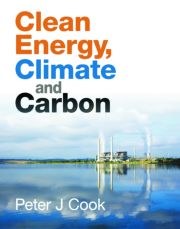Clean Energy, Climate n Carbon
$39.99 $27.99 $12.00
Clean Energy, Climate and Carbon by Professor Peter Cook, CBE, FTSE, Cooperative Research Centre for Greenhouse Gas Technologies, Canberra, describes how carbon sequestering or geosequestration works (carbon dioxide capture and in-ground or geological storage), and the challenges we face in the widespread adoption of carbon sequestration and why it could prove to be extremely important.
Clean Energy, Climate and Carbon is about the global challenge to decrease greenhouse gases. It explains the changing levels of atmospheric carbon dioxide through the ages and what caused it, then considers a wide range of energy technologies to decrease carbon dioxide emissions. How can we capture carbon dioxide from flue gases? How do we transport it? How do we store it in suitable rocks? What are suitable rocks and where do we find them? How do we know the carbon dioxide will remain trapped once it is injected underground? What does Carbon Capture and Storage (CCS) cost and how do those costs compare with other technology options?
Clean Energy, Climate and Carbon also explores the political environment in which the discussion on clean energy technology options is occurring. What will a price on carbon do for technology uptake and what are the prospects of cutting our carbon emissions by 2020 and of making even deeper cuts by 2050? What will the technology mix look like by that time?
For people who are concerned about climate change, or who want to learn more about clean energy technologies, including CCS (Carbon Capture and Storage), this is the definitive view of the opportunities and the challenges we face in decreasing our carbon emissions despite a global increase in energy demand.
About the Author: Professor Peter Cook, CBE, FTSE, is a distinguished earth scientist with an outstanding international reputation and many publications on greenhouse gas, energy and resource issues to his credit, including as a Coordinating Lead Author of the IPCC Special Volume of Carbon Dioxide Capture and Storage. He was the Director of the British Geological Survey from 1990 to 1998 and until 2011 the CEO of CO2CRC, one of the world’s leading collaborative research bodies focused on greenhouse gas technologies. He is currently a consultant on energy and greenhouse issues, Senior Advisor to CO2CRC and Professorial Fellow at the University of Melbourne.
Table of Contents
1 The context - Climate change science: the controversies
2 CO2 and climate change
3 Where and why are we producing so much CO2 ?
4 Technology options for decreasing CO2 emissions
5 The mitigation mix
6 Where and how can we capture CO2 ?
7 How can we transport CO2 ?
8 Storing CO2
9 How do we know CCS will be effective?
10 The cost of clean energy
11 The technology and the politics of clean energy

Share: